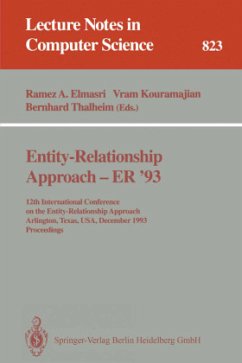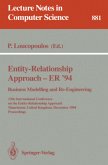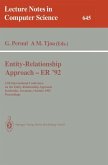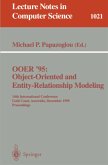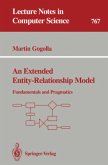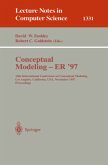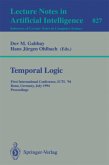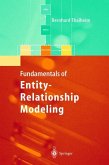Elmasri12th International Conference on the Entity-Relationship Approach, Arlington, Texas, USA, December 15 - 17, 1993. Proceedings
Entity-Relationship Approach - ER '93
12th International Conference on the Entity-Relationship Approach, Arlington, Texas, USA, December 15 - 17, 1993. Proceedings
Mitarbeit:Elmasri, Ramez A.; Kouramajian, Vram; Thalheim, Bernhard
Elmasri12th International Conference on the Entity-Relationship Approach, Arlington, Texas, USA, December 15 - 17, 1993. Proceedings
Entity-Relationship Approach - ER '93
12th International Conference on the Entity-Relationship Approach, Arlington, Texas, USA, December 15 - 17, 1993. Proceedings
Mitarbeit:Elmasri, Ramez A.; Kouramajian, Vram; Thalheim, Bernhard
- Broschiertes Buch
- Merkliste
- Auf die Merkliste
- Bewerten Bewerten
- Teilen
- Produkt teilen
- Produkterinnerung
- Produkterinnerung
This volume contains the proceedings of the 12th International Conference of the Entity-Relationship Approach, held in Arlington, Texas in December 1993; it contains the revised versions of 42 papers selected for presentation at the conference from a total of 87 submissions.The volume presents many of the most important results on the ERA published since the predecessor conference ER '92. It is organized in sections on object-oriented models, query languages, applications of the ER model, knowledge-based modeling, data modeling, schema integration, reuse and reengineering, integrating ER and…mehr
Andere Kunden interessierten sich auch für
![Entity-Relationship Approach - ER '94. Business Modelling and Re-Engineering Entity-Relationship Approach - ER '94. Business Modelling and Re-Engineering]() LoucopoulosEntity-Relationship Approach - ER '94. Business Modelling and Re-Engineering77,99 €
LoucopoulosEntity-Relationship Approach - ER '94. Business Modelling and Re-Engineering77,99 €![Entity-Relationship Approach - ER '92 Entity-Relationship Approach - ER '92]() Günther Pernul / A Min Tjoa (eds.)Entity-Relationship Approach - ER '9239,99 €
Günther Pernul / A Min Tjoa (eds.)Entity-Relationship Approach - ER '9239,99 €![OOER '95 Object-Oriented and Entity-Relationship Modeling OOER '95 Object-Oriented and Entity-Relationship Modeling]() PapazoglouOOER '95 Object-Oriented and Entity-Relationship Modeling39,99 €
PapazoglouOOER '95 Object-Oriented and Entity-Relationship Modeling39,99 €![An Extended Entity-Relationship Model An Extended Entity-Relationship Model]() Martin GogollaAn Extended Entity-Relationship Model39,99 €
Martin GogollaAn Extended Entity-Relationship Model39,99 €![Conceptual Modeling - ER '97 Conceptual Modeling - ER '97]() EmbleyConceptual Modeling - ER '9739,99 €
EmbleyConceptual Modeling - ER '9739,99 €![Temporal Logic Temporal Logic]() GabbayTemporal Logic77,99 €
GabbayTemporal Logic77,99 €![Entity-Relationship Modeling Entity-Relationship Modeling]() Bernhard ThalheimEntity-Relationship Modeling38,99 €
Bernhard ThalheimEntity-Relationship Modeling38,99 €-
-
-
This volume contains the proceedings of the 12th International Conference of the Entity-Relationship Approach, held in Arlington, Texas in December 1993; it contains the revised versions of 42 papers selected for presentation at the conference from a total of 87 submissions.The volume presents many of the most important results on the ERA published since the predecessor conference ER '92. It is organized in sections on object-oriented models, query languages, applications of the ER model, knowledge-based modeling, data modeling, schema integration, reuse and reengineering, integrating ER and object-orientation, conceptual clustering, modeling time and data semantics.
Produktdetails
- Produktdetails
- Lecture Notes in Computer Science 823
- Verlag: Springer, Berlin
- 1994.
- Seitenzahl: 548
- Erscheinungstermin: 28. Juli 1994
- Englisch
- Abmessung: 235mm x 155mm x 30mm
- Gewicht: 709g
- ISBN-13: 9783540582175
- ISBN-10: 3540582177
- Artikelnr.: 09251168
- Herstellerkennzeichnung Die Herstellerinformationen sind derzeit nicht verfügbar.
- Lecture Notes in Computer Science 823
- Verlag: Springer, Berlin
- 1994.
- Seitenzahl: 548
- Erscheinungstermin: 28. Juli 1994
- Englisch
- Abmessung: 235mm x 155mm x 30mm
- Gewicht: 709g
- ISBN-13: 9783540582175
- ISBN-10: 3540582177
- Artikelnr.: 09251168
- Herstellerkennzeichnung Die Herstellerinformationen sind derzeit nicht verfügbar.
The Object Flow Model: A formal framework for describing the dynamic construction, destruction and interaction of complex objects.- On complex objects and versioning in complex environments.- Application and system prototyping via an extensible object-oriented environment.- Reflection in a uniform behavioral object model.- Relative constraints in ER data models.- Design and implementation of derived entities.- Searching for compositions in ER schemes.- Enhancing the quality of conceptual database specifications through validation.- Functional dependencies generalized for temporal databases that include object-identity.- Temporal extensions to a uniform behavioral object model.- TOOSQL- a temporal object-oriented query language.- A taxonomy for schema versioning based on the relational and Entity Relationship Models.- Neighborhood/conceptual query answering with imprecise/incomplete data.- The entity-relationship model for multilevel security.- HDM2: Extending the E-R approach to hypermedia application design.- Database schema design: A perspective from natural language techniques to validation and view integration.- Transformation of requirement specifications expressed in natural language into an EER model.- A commonsense reasoning facility based on the entity-relationship model.- DETERM: Deterministic Event-Tuned Entity-Relationship Modeling.- A semantic comparison of the modelling capabilities of the ER and NIAM models.- From entity-relationship models to role-attribute models.- Analysis of binary relationships within ternary relationships in ER modeling.- Using conceptual graph theory to support schema integration.- Integration of heterogeneous object schemas.- The role of meta models in federating system modelling techniques.- Multilevel schema integration.- Reuseof object-oriented requirement specifications.- Performance evaluation of reverse engineering relational databases into extended Entity-Relationship models.- Transformation-based database reverse engineering.- Integrating the ER approach in an OO environment.- An extended entity-relationship approach to data management in object-oriented systems.- On mapping ER and relational models into OO schemas.- A repository meta model for interactive systems.- ER-based Information Retrieval in a mixed database environment.- A framework for automatic clustering of semantic models.- Extending ER model clustering by relationship clustering.- Semantic interoperability of multitemporal relational databases.- Modeling time: Adequacy of three distinct time concepts for temporal databases.- Towards a unifying logic formalism for semantic data models.- Knowledge-based approach for abstracting hierarchical and network schema semantics.- A state-space approach for database redesign.
The Object Flow Model: A formal framework for describing the dynamic construction, destruction and interaction of complex objects.- On complex objects and versioning in complex environments.- Application and system prototyping via an extensible object-oriented environment.- Reflection in a uniform behavioral object model.- Relative constraints in ER data models.- Design and implementation of derived entities.- Searching for compositions in ER schemes.- Enhancing the quality of conceptual database specifications through validation.- Functional dependencies generalized for temporal databases that include object-identity.- Temporal extensions to a uniform behavioral object model.- TOOSQL- a temporal object-oriented query language.- A taxonomy for schema versioning based on the relational and Entity Relationship Models.- Neighborhood/conceptual query answering with imprecise/incomplete data.- The entity-relationship model for multilevel security.- HDM2: Extending the E-R approach to hypermedia application design.- Database schema design: A perspective from natural language techniques to validation and view integration.- Transformation of requirement specifications expressed in natural language into an EER model.- A commonsense reasoning facility based on the entity-relationship model.- DETERM: Deterministic Event-Tuned Entity-Relationship Modeling.- A semantic comparison of the modelling capabilities of the ER and NIAM models.- From entity-relationship models to role-attribute models.- Analysis of binary relationships within ternary relationships in ER modeling.- Using conceptual graph theory to support schema integration.- Integration of heterogeneous object schemas.- The role of meta models in federating system modelling techniques.- Multilevel schema integration.- Reuseof object-oriented requirement specifications.- Performance evaluation of reverse engineering relational databases into extended Entity-Relationship models.- Transformation-based database reverse engineering.- Integrating the ER approach in an OO environment.- An extended entity-relationship approach to data management in object-oriented systems.- On mapping ER and relational models into OO schemas.- A repository meta model for interactive systems.- ER-based Information Retrieval in a mixed database environment.- A framework for automatic clustering of semantic models.- Extending ER model clustering by relationship clustering.- Semantic interoperability of multitemporal relational databases.- Modeling time: Adequacy of three distinct time concepts for temporal databases.- Towards a unifying logic formalism for semantic data models.- Knowledge-based approach for abstracting hierarchical and network schema semantics.- A state-space approach for database redesign.

